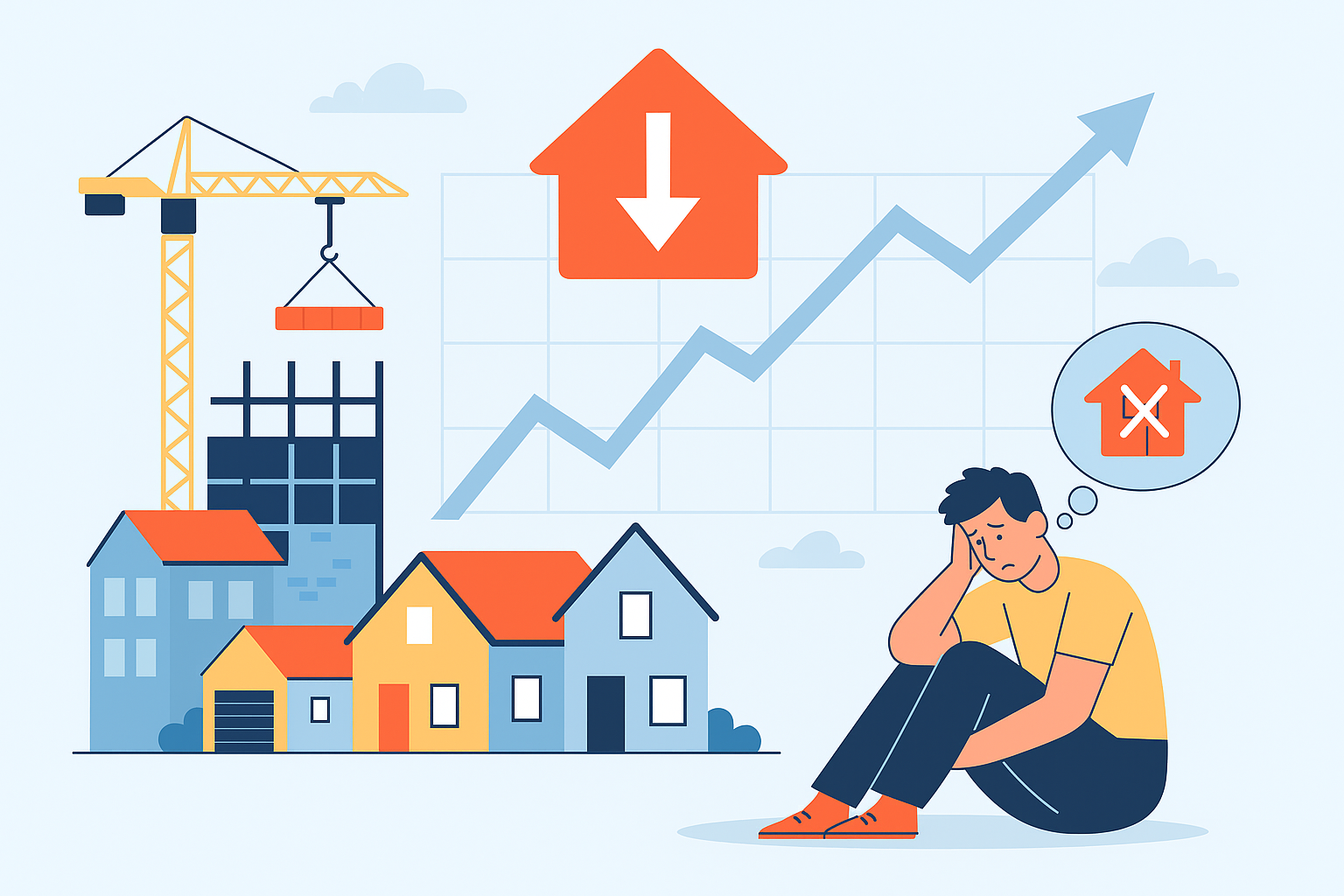
25 Jul Construction Surged, But the Housing Shortage Deepened
The United States continues to face a significant housing shortfall, despite recent construction activity hitting record highs. According to Zillow, the country was still lacking about 4.7 million homes in 2023, highlighting that even one of the largest building booms in recent history wasn’t enough to bridge the gap.
In fact, the shortage grew by 159,000 units from the previous year. The root of the issue lies in the pace of household formation—around 1.8 million new households are created annually, while only 1.4 million new homes are being built.
Younger Buyers Bear the Brunt
The housing crunch has hit millennials and Gen Z particularly hard. Many are now sharing homes with unrelated individuals as both home prices and mortgage rates remain high. It’s not just about the number of available homes—it’s also about affordability. Without lower borrowing costs and stronger wage growth, new buyers are struggling to gain a foothold in the housing market.
Home Prices Climb Faster Than Wages
The Wall Street Journal noted that by 2024, the median cost of a single-family home had reached $412,500. However, income levels have not kept up, and rising home insurance premiums are compounding the financial burden of ownership.
To add to the challenge, the income needed to afford a typical 30-year mortgage has surged by 60% since 2021. Ongoing labor shortages in construction, partly due to stricter immigration policies, could also slow down new builds.
The U.S. is caught in a difficult cycle: there’s a desperate need for more homes, but many communities are resistant to increased density. This tug-of-war between pro-housing groups (YIMBYs) and those opposed to more development (NIMBYs) is helping to push home prices even higher.
Tight Inventory in America’s Most Expensive Cities
Unsurprisingly, the most costly cities are also the most under-supplied. Zillow data from 2023 shows the largest housing deficits in the following metropolitan areas:
- New York City: 402,361 homes
- Los Angeles: 338,750 homes
- Boston: 150,541 homes
- San Francisco: 139,990 homes
- Washington, D.C.: 132,238 homes
Low Inventory May Persist for Years
In 2023, builders completed 1.45 million homes, with 2024 expected to add 1.63 million more. But even these gains may not be enough. U.S. News & World Report estimates the nation is still short by approximately 4.5 million homes. The National Association of Home Builders warns that this shortfall could extend through the decade.
Jason Furman, a professor of economic policy at Harvard, points to a clear solution: expanding supply, particularly through multifamily housing. However, high costs and restrictive zoning continue to limit progress. As a result, many people are relocating to more affordable cities.
Where Investors Should Focus: Cities Under $300K
For those considering real estate investment, areas with lower property values offer more promising opportunities. Redfin has identified ten cities where median home prices remain below $300,000—making them attractive not just to investors, but also to renters hoping to transition into homeownership through creative models like rent-to-own.
Here are the top contenders:
- Detroit, MI
- Median Price: $180,950
- 10-Year Growth: +158.5%
Once in decline, Detroit is undergoing a transformation. Though prices have surged recently, it remains the most affordable large metro in the country.
- Cleveland, OH
- Median Price: $227,000
- 10-Year Growth: +106.4%
With revitalized neighborhoods and a strong cultural scene, Cleveland is attracting new residents, though gentrification is rapidly reshaping the city.
- Dayton, OH
- Median Price: $229,500
- 10-Year Growth: +118.6%
While culturally rich and affordable, Dayton’s high poverty rate means investors must be selective in choosing neighborhoods.
- Rochester, NY
- Median Price: $230,750
- 10-Year Growth: +98.9%
Known for repurposed historic spaces and a vibrant arts culture, Rochester offers affordability paired with livability.
- Pittsburgh, PA
- Median Price: $235,000
- 10-Year Growth: +74.1%
With a tech-forward economy and scenic charm, Pittsburgh is a solid investment choice, though competition for good deals is rising.
- Buffalo, NY
- Median Price: $243,000
- 10-Year Growth: +116.4%
Buffalo’s downtown revival and investment in tech make it an exciting, though increasingly competitive, market.
- McAllen, TX
- Median Price: $250,000
- 10-Year Growth: +93.8%
Border city McAllen offers low housing costs and a strong sense of community, but lower average wages could impact returns.
- Baton Rouge, LA
- Median Price: $258,815
- 10-Year Growth: +49.6%
Despite its rich culture and attractive pricing, high poverty rates may present challenges for rental property investors.
- St. Louis, MO
- Median Price: $263,850
- 10-Year Growth: +80.1%
Offering urban amenities at a reasonable price, St. Louis is ideal for those leaving high-cost coastal cities.
- El Paso, TX
- Median Price: $264,000
- 10-Year Growth: +91.1%
El Paso’s affordability and cultural appeal are offset by local economic challenges that investors should weigh carefully.
Final Thoughts
Investors hoping for falling interest rates to spark a housing revival may be waiting longer than expected. Until developers gain confidence to launch more large-scale projects and zoning restrictions ease, housing inventory will remain tight.
The best strategy is to focus on where opportunities still exist. For many investors, that means turning to affordable markets—places with room for growth, livability, and the potential to generate long-term returns.

